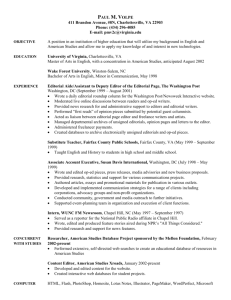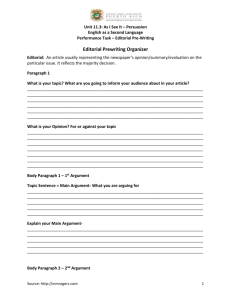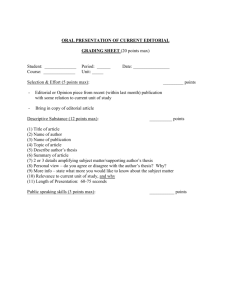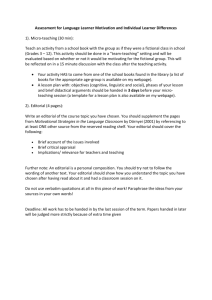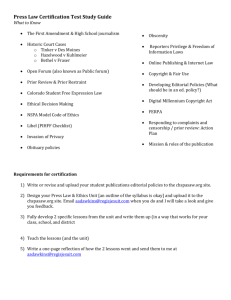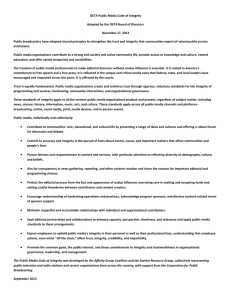Dear AP Language and Composition Student
advertisement
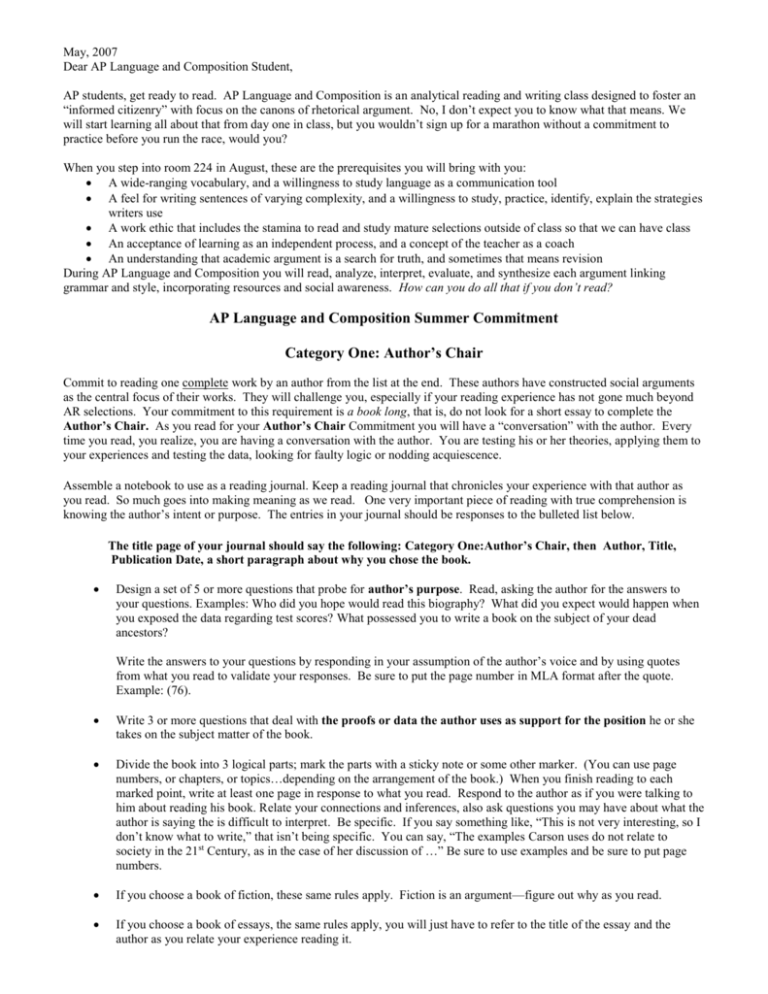
May, 2007 Dear AP Language and Composition Student, AP students, get ready to read. AP Language and Composition is an analytical reading and writing class designed to foster an “informed citizenry” with focus on the canons of rhetorical argument. No, I don’t expect you to know what that means. We will start learning all about that from day one in class, but you wouldn’t sign up for a marathon without a commitment to practice before you run the race, would you? When you step into room 224 in August, these are the prerequisites you will bring with you: A wide-ranging vocabulary, and a willingness to study language as a communication tool A feel for writing sentences of varying complexity, and a willingness to study, practice, identify, explain the strategies writers use A work ethic that includes the stamina to read and study mature selections outside of class so that we can have class An acceptance of learning as an independent process, and a concept of the teacher as a coach An understanding that academic argument is a search for truth, and sometimes that means revision During AP Language and Composition you will read, analyze, interpret, evaluate, and synthesize each argument linking grammar and style, incorporating resources and social awareness. How can you do all that if you don’t read? AP Language and Composition Summer Commitment Category One: Author’s Chair Commit to reading one complete work by an author from the list at the end. These authors have constructed social arguments as the central focus of their works. They will challenge you, especially if your reading experience has not gone much beyond AR selections. Your commitment to this requirement is a book long, that is, do not look for a short essay to complete the Author’s Chair. As you read for your Author’s Chair Commitment you will have a “conversation” with the author. Every time you read, you realize, you are having a conversation with the author. You are testing his or her theories, applying them to your experiences and testing the data, looking for faulty logic or nodding acquiescence. Assemble a notebook to use as a reading journal. Keep a reading journal that chronicles your experience with that author as you read. So much goes into making meaning as we read. One very important piece of reading with true comprehension is knowing the author’s intent or purpose. The entries in your journal should be responses to the bulleted list below. The title page of your journal should say the following: Category One:Author’s Chair, then Author, Title, Publication Date, a short paragraph about why you chose the book. Design a set of 5 or more questions that probe for author’s purpose. Read, asking the author for the answers to your questions. Examples: Who did you hope would read this biography? What did you expect would happen when you exposed the data regarding test scores? What possessed you to write a book on the subject of your dead ancestors? Write the answers to your questions by responding in your assumption of the author’s voice and by using quotes from what you read to validate your responses. Be sure to put the page number in MLA format after the quote. Example: (76). Write 3 or more questions that deal with the proofs or data the author uses as support for the position he or she takes on the subject matter of the book. Divide the book into 3 logical parts; mark the parts with a sticky note or some other marker. (You can use page numbers, or chapters, or topics…depending on the arrangement of the book.) When you finish reading to each marked point, write at least one page in response to what you read. Respond to the author as if you were talking to him about reading his book. Relate your connections and inferences, also ask questions you may have about what the author is saying the is difficult to interpret. Be specific. If you say something like, “This is not very interesting, so I don’t know what to write,” that isn’t being specific. You can say, “The examples Carson uses do not relate to society in the 21st Century, as in the case of her discussion of …” Be sure to use examples and be sure to put page numbers. If you choose a book of fiction, these same rules apply. Fiction is an argument—figure out why as you read. If you choose a book of essays, the same rules apply, you will just have to refer to the title of the essay and the author as you relate your experience reading it. Category Two: Wildcat Editorial Read editorials in major national newspapers. Newspapers can be found online without a subscription, and they can be great resources for current social argument, or they can be purchased in newstands. The major newspapers carry editorials by people who have become very clever at trying to sway public opinion. Editorial columnists do not restrict their topics to politics, but speak out about all sorts of issues plaguing society, i.e. the ways certain English language words should be used, or the changes that should be made in baseball rules. A list of editorial columnists is included below. Read a minimum of two editorials in June, two more in July, and one in August. Designate a place in your reading journal titled Wildcat Editorial to write the editorial responses as explained below. Write the columnist’s name, the title of the editorial, and where you found it as a heading for each entry. See below.* Cut out the editorial, or copy it from your online source. Put it in your journal. Underline passages you find worthy of comment. In the journal, write a multi-paragraph response to the columnist. If you disagree, present your case and your data. Try to write in the same style the writer uses. Try the metaphors, the short/long sentences, the irony and wit. Category Three: Visual Literacy Believe it or not, artists often paint their argument. Spend some time looking at great paintings. You can do this online, in magazines, in books that feature an artist or a period—go to the library. You can go to the Nelson, you can visit a gallery on your summer vacation. Try to stretch beyond the more common masterpieces to study the works of some artists that are acclaimed, but perhaps not the “T-shirt logo” variety of popular. Study at least 5 great masterpieces. Return to the concept of being in the company of the creator of the work. You and the artist should have a discussion through your journal* (ask questions, write imagined responses) about use of color, about form, about subject matter and perspective, about medium, the historical, cultural, and social implications of the work. Include questions and responses related to the audience the author hoped to reach, and to the current relevance of the work. Fill a page or two (after you complete the introduction requirements) with your questions and the responses you imagine the artist would make. *How to report: Write your responses in your reading journal. The title page should say Visual Literacy Reading Experiences. Designate a part of your reading journal to Visual Literacy. Write the title of the work, the artist’s name, where you saw the artwork, a brief bio the includes the time period in which the work was completed, something about influences, and the country the artist is from. Write about the questions and answers listed above. When possible, include a print of the painting from the internet. In addition to the box of directions above, write a paragraph of personal response to the painting. “This is what I found compelling about Picasso’s The Tragedy…” is a good response starter, whereas, “I liked it” does not actually say anything measurable. ****************************************************************************************************** Please hand in your reading journals on the first day of class, or you may email your journal to me at the address below any time before the first day of class. The first day of class is a firm deadline for handwritten reading journals. Don’t miss it. My email address: arnettk@usd416.org I will check my mail every day to see if you have questions or want to discuss your work with me. Read about the book and the author before you choose so that you can be learning about time periods or topics that hold your interest. Start early. I cannot wait to see you in August and to hear about your summer reading. AP Language and Composition List of Representative Authors (From the AP Lang course description) Autobiographers and Diarists Maya Angelou, James Boswell, Judith Ortiz Cofer, Charles Dana, Thomas De Quincey, Frederick Douglass, Benjamin Franklin, Lillian Hellman, Helen Keller, Maxine Hong Kingston, T.E, Lawrence, John Henry Newman, Samuel Pepys, Richard Rodriquez, Richard Wright, Malcolm X, Anzia Yezierska Biographers and History Writers Walter Jackson Bate, James Boswell, Thomas Carlyle, Winston Churchill, Vine Deloria, Jr., Leon Edel, Richard Ellmann, Shelby Foote, John Hope Franklin, Antonia Fraser, Edward Gibbon, Richard Holmes, Gerda Lerner, Thomas Macaulay, Samuel Eliot Morison, Francis Parkman, Arnold Rampersad, Simon Schama, Arthur M. Schlesinger, Ronald Takaki, George Trevelyan, Barbara Tuchman Critics Paula Gunn Allen, Gloria Anzaldua, Michael Arlen, Matthew Arnold, Kenneth Clark, Samuel Taylor Coleridge, Arlene Croce, Ralph Waldo Emerson, Henry Louis Gates, Jr., William Hazlitt, bell hooks, Samuel Johnson, Pauline Kael, Joyce Carol Oates, Walter Pater, John Ruskin, George Santayana, George Bernard Shaw, Susan Sontag, Cornel West, Oscar Wilde, Edmund Wilson Essayists and Fiction Writers Joseph Addison, James Agee, Margaret Atwood, Francis Bacon, James Baldwin, G.K. Chesterton, Joan Didion, Ralph Waldo Emerson, Paul Fussell, Mavis Gallant, Nadine Gordimer, Edward Hoagland, Zora Neale Hurston, Jamaica Kincaid, Charles Lamb, Norman Mailer, Nancy Mairs, Mary McCarthy, N. Scott Momaday, Michel de Montaigne, V.S. Naipaul, Tillie Olsen, George Orwell, Cynthia Ozick, Ishmael Reed, Adrienne Rich, Mordecai Richler, Sharman Apt Russell, Scott Russell Sanders, Richard Selzer, Richard Steele, Shelby Steele, Henry David Thoreau, John Updike, Alice Walker, Eudora Welty, E.B. White, Terry Tempest Williams, Virginia Woolf Journalists Roger Angell, Maureen Dowd, Elizabeth Drew, Nora Ephron, M.F.K. Fisher, Frances Fitzgerald, Janet Flanner (Genet), Ellen Goodman, David Halberstam, Andy Logan, John McPhee, H.L. Mencken, Jan Morris, David Remnick, Red Smith, Lincoln Steffens, Paul Theroux, Calvin Trillin, Tom Wolfe Political Writers Hannah Arendt, Simone de Beauvoir, William F. Buckley, Jean de Crevecoeur, W.E.B. DuBois, Margaret Fuller, John Kenneth Galbraith, Charlotte Perkins Gilman, Thomas Hobbes, Thomas Jefferson, George Kennan, Martin Luther King, Jr., Lewis H. Lapham, John Locke, Niccolo Machiavelli, John Stuart Mill, John Milton, Thomas More, Thomas Paine, Olive Schreiner, Jonathan Swift, Alexis de Tocqueville, Gore Vidal, George Will, Garry Wills, Mary Wollstonecraft Science and Nature Writers Edward Abbey, Wendell Berry, Jacob Bronowski, Rachel Carson, Charles Darwin, Annie Dillard, Gretel Ehrlich, Loren Eiseley, Stephen Jay Gould, Evelyn Fox Keller, Barry Lopez, Peter Matthiessen, Margaret Mead, John Muir, David Quammen, Carl Sagan, Lewis Thomas, Jonathan Weiner Editorial Columnists Sidney Blumenthal, David Brooks, David Broder, Bill Buckley, Richard Cohen, Ann Coulter, Maureen Dowd, Roger Ebert, Ellen Goodman, Christopher Hitchens, Molly Ivins, Mort Kondracke, Joe Klein, Paul Krugman, Dick Morris, Peggy Noonan, Bob Novak, Anna Quindlen, Richard Roeper, Bill Safire, Liz Smith, Thomas Sowell, Andrew Sullivan, George Will, Dave Berry, Nat Hentoff, Mona Charen, Stephen Battaglio, Suzanne Fields, Tony Snow (Try http://www.drudgereport.com for many of these, or google them.) ***Risk reading out of your comfort zone—don’t just retreat into the novels as a “safe” choice. AP Language and Composition Summer Reading and Commitment Acknowledgement Form Required by the end of May (May 31, 2008) I have read the summer requirements for AP Language and Composition. This is my reading and visual literacy plan: Signature and date: (In the space below, please use a calendar to help you visualize your plan for completing your summer reading commitment.) Author’s Chair Selection: _______________________________________________ Author:___________________ June July August Your signature: Your email address: Complete your commitment form. Insert it into an envelope. 1. Your reading plan and your signed commitment may be put in my school mailbox the last day of school (May 22, 2008), or 2. mailed and postmarked by May 26, 2008. If you miss those options, you must 3. email your commitment so that I receive it no later than May 31, 2008. Mail this commitment to Katie Arnett Louisburg High School 202 Aquatic Drive PO Box 399 Louisburg, KS 66053 OR email your commitment in the form of a short paragraph that addresses your plan over the summer months and your typed signature, to arnettk@usd416.org
